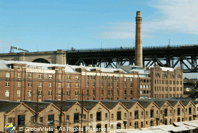Brief History of The Rocks
 The Rocks is the foundation place of Sydney and Australia’s most important historical site. Located on the western side of Sydney Cove, The Rocks are named after the sandstone outcrops located on the hillside. Almost immediately following Captain Arthur Phillips’s arrival with the First Fleet, convicts were sent ashore to clear land for setting up tents and huts. Many of the tents and huts were built along this rocky sandstone outcrop.
The Rocks is the foundation place of Sydney and Australia’s most important historical site. Located on the western side of Sydney Cove, The Rocks are named after the sandstone outcrops located on the hillside. Almost immediately following Captain Arthur Phillips’s arrival with the First Fleet, convicts were sent ashore to clear land for setting up tents and huts. Many of the tents and huts were built along this rocky sandstone outcrop.
The Rocks soon became the centre of the colony’s maritime and commercial activity. The area became home to convicts, officers, whalers, sailors and street gangs as warehouses and bond stores were built. Slums soon emerged and the area became notorious for gangs and thugs.
The area fell into total decline after the modernisation of shipping and storage facilities and industry moved away from Circular Quay. An outbreak of the bubonic plague in 1900 and the construction of the Harbour Bridge also added to the area’s decline. It wasn’t until the 1970’s when re-development of the area was undertaken by people in the building industry and the union movement. The Sydney Cove Re-development Authority was established to oversee the successful transition from slum to historical tourist precinct.
Things You May Not Know About The Rocks
 In 1900 the bubonic plague spread throughout The Rocks area.
In 1900 the bubonic plague spread throughout The Rocks area.
Following the arrival of the First Fleet, female convicts were picked to be nurses for the makeshift hospitals set up in The Rocks area. The area is now known as Nurse’s Walk.
Cadman’s Cottage is the oldest surviving house in Sydney.
The Argyle Stores are one of the earliest bond stores built in Australia.
The Hero of Waterloo hotel has secret tunnels in its basement, which were used to smuggle rum and unsuspecting drunks back and forth to the harbour.
Henry Lawson captured the essence of the early years of the area in his poem ‘Captain of the Push’. During the 1800s The Rocks was virtually run by a gang of larrikins known as ‘The Push’.
There are 13 pubs in The Rocks precinct. Prior to the 1970’s all pubs had to close at 6pm sharp. Patrons would throw down as many beers as they could before the publican stopped serving. This ritual became known as the ‘six-o’clock swill’.
Hidden beneath George Street lie the original woodblock pavers.
Things Are Looking Up At The Rocks
The original buildings of The Rocks were mostly constructed from local sandstone from which the area derived its name. The area consisted mainly of warehouses and public houses with the majority of local residents being convicts, sailors, soldiers, and prostitutes. By the 1900’s many of the buildings were already in serious decay and the area was little more than a slum. Adding further to the area’s woes was the outbreak of the bubonic plague, which forced the State Government to resume much of the areas around The Rocks and Darling Harbour. All was to be flattened, but re-development plans were stalled when World War I broke out.
In the 1920s hundreds of buildings were demolished to make way for the Sydney Harbour Bridge, but again the area was saved, due this time to the outbreak of World War II.
In the 1960s the Sydney Cove Redevelopment Authority made a grand attempt at having the whole area demolished and replaced by high-density residential buildings. It didn’t take long before a group of disgruntled locals formed the ‘Rocks Residents Group’ to oppose the plans. Well, as you can imagine all hell broke out when the group imposed a Green ban on the area. After numerous arrests, demonstrations, political powerplays and everything else which goes with a good battle, much of The Rocks area was saved. Through plenty of renovations, The Rocks was transformed from slums to one of Sydney’s most popular tourist precincts. Thank you Rocks Residents Group.
The most interesting architectural areas can be found on George Street, Harrington Street and Argyle Street. There are several bond stores still standing, the Metcalfe Bond Stores, Campbell, Argyle Stores and the ASN stores. Historical buildings of note in the area are Lilyvale, Cadman’s Cottage, and Garrison Church.
